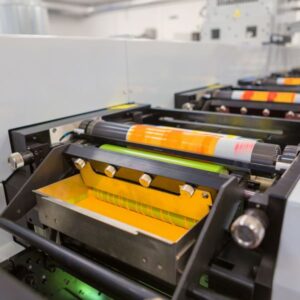What is Flexographic Printing?
From your morning cup of coffee to the millions of packages delivered daily, flexographic printing has found its place all around us. Flexographic printing is a versatile and widely used production process that caters to many industries. Also known as “flexo printing,” this technique combines letterpress and rotogravure elements to create high-quality prints on a wide variety of substrates.
Zeller+Gmelin has been a leading producer of UV and LED flexographic printing inks for decades. This blog will discuss how flexographic printing works, its typical applications, and its advantages and disadvantages. For any questions or to discuss your unique flexo operations, please get in touch with Zeller+Gmelin. We’re here to serve you!
Understanding Flexographic Printing
“Flexo printing” refers to a relief printing process that uses flexible plates made from rubber or polymer materials. These plates are wrapped around rotating cylinders on the printing press. The image areas on the plate are raised, while the non-image areas are recessed. The ink is transferred to the printing plates via an anilox roll or sleeve and transfers the image onto the substrate as it passes through the rolls, creating a printed impression. Flexographic printing presses are manufactured in 4 main formats, according to the size of the printing web: narrow-web, mid-web, wide-web, and corrugated. All in all, flexographic printing is a prevalent print method used for various applications and produced worldwide.
Equipment Involved in Flexographic Printing
Printing Plate
Printing plates serve as the image carrier in the flexo printing process. They are typically made of rubber or polymer material and engraved with the raised image areas used to transfer the ink to the substrate. Printing plates are wrapped around a printing cylinder to create a continuous surface. Each color or element of the design usually requires a separate printing plate.
Anilox Roll
The anilox roll is a crucial part of the flexo printing process. Its primary function is to uniformly distribute solvent-based, water-based, or UV/LED inks onto the printing plate in a consistent even layer. Anilox rolls are engraved with thousands of microscopic cells, and as they rotate in the ink reservoir or ink chamber, the engraved cells become filled with ink while a doctor blade removes the excess ink. The anilox then comes in contact with the raised image on the printing plate and transfers a uniform layer of ink to be printed on the substrate.
Anilox cells can be laser, mechanically, or electromechanically engraved and come in various geometries. The most popular cell geometry is the 60˚ Hexagonal, but anilox engravings also come in 45˚ Quad, Longcell, Channel, Trihelical, Positive, and many more!
Substrates
Flexography can print on various substrates, making it a suitable printing method for multiple products. The choice of substrate depends on the specific requirements of the product being printed. Common substrates include:
Paper: This common substrate comes in various forms, from coated papers for labels to packaging.
Paperboard: A thicker, sturdy material, paperboard is used for food and consumer packaging, such as cereal boxes, cosmetic cartons, and beverage packaging.
Plastic Films: Flexo printing is well suited for printing on flexible packaging materials such as plastic bags, shrink sleeves, and pouches.
Foils: To add an embellished finish or a decorative shine, flexo printing can utilize metallic substrates.
Corrugated board: From simple brown boxes with black text to eye-catching point-of-purchase, corrugated board is a typical substrate in flexo printing.
Printing Cylinder
Printing Cylinders carry the printing plates and transfer the inked image onto the substrate using precise pressure. Multiple cylinders can be used for multi-color printing processes.
Dryer
After printing, the substrate passes through a dryer section that evaporates the solvents from the ink, leaving a dry and finished print. If you’re using UV or LED inks, this section will consist of high-powered UV/LED lamps that quickly convert the ink into a solid before the next print station.
Common Applications of Flexographic Printing
Packaging
With the capability to inside print and produce packaging at a high volume, flexo printing is extensively used for packaging such as food packaging, cosmetics, pharmaceuticals, protective folding cartons, product labels, flexible packaging, and much more!
Corrugated Packaging
In the production of corrugated boxes, flexographic printing is used to add block letter print and icons or more detailed branded designs to the corrugated board’s outside and/or inside surface. Examples of corrugated flexo print are packaging for electronics, furniture, shoes, eCommerce, logistics, and other consumer goods.
Labels
Flexo printing is preferred for producing labels for food and beverage, wines & spirits, cosmetics, pharmaceuticals, and logistics. The ability to print vibrant, high-quality labels efficiently and achieve specialty print effects in narrow web flexo makes this printing method a popular option for label applications.
Flexible Packaging
The flexibility of flexographic printing makes it a go-to choice for producing flexible packaging materials like stand-up pouches, bags, sachets, shrink sleeves, and more. It can handle the unique requirements of these materials, such as heat resistance, full branding wraps, tamper resistance, and product security.
Advantages & Disadvantages of Flexographic Printing
Flexographic printing offers several advantages:
Quality: When all processes and print components are controlled, flexo can achieve an impressive level of print quality for its customers. With optional units for cold foil, specialty coatings, and varnishes, flexo printing can achieve an incredibly stunning print at a more cost-effective price.
Versatility: Flexography can print on a wide range of substrates, making it a flexible printing option suitable for various industries and applications. Many flexo presses are modular, capable of adding specialty units for full, one pass, in-line production.
High Speed: Flexo presses can achieve high production speeds, over 500m/min, making it an efficient option for medium to large print runs.
Cost-effective: Flexo printing is more cost-effective than offset printing and can achieve quality for medium to large print jobs more economically. Cleaning and maintenance costs are also more economical than other printing methods.
Alternatively, flexo printing also has some disadvantages:
Image Resolution: Compared to offset printing, flexo has some limitations in achieving high-resolution images though, this difference is becoming smaller daily.
Setup Time: The job changeover and setup process for flexo printing can be time-consuming. However, many OEMs have created quick changeover systems, improving set-up times tremendously.
Not ideal for Short Runs: While it is efficient for medium to large print runs, flexo printing is less cost-effective for short runs due to the investment in plates, ink, and anilox rolls, along with the setup times involved.
Here for the Long Run
Flexographic printing has carved its niche in printing technologies for decades. Its wide range of applications, efficient production capabilities, high-quality end products, and cost-effectiveness make it a popular printer choice. However, its limitations in image resolution and suitability for short runs should be considered when selecting the printing method for the job. As technology evolves, Zeller+Gmelin will continue to be at the cutting edge of flexographic printing, offering high-performance UV and LED printing inks for your most challenging applications. As you begin or continue your journey into flexographic printing, consider the ink specialists at Zeller+Gmelin for any questions or opportunities. To learn more about Z+G flexographic inks, click here or contact our team to discuss your unique print goals.



